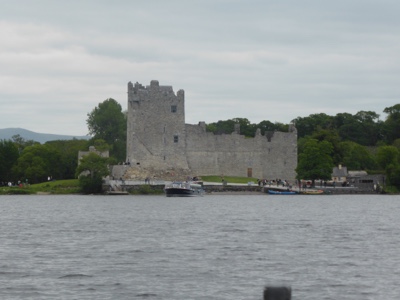Our walk took us between the Purple Mountain and the Macgillycuddy's Reek (a reek is a new, craggy mountain) on the Dunloe Gape road. These are Ireland's highest mountains at about 3400 feet. This used to be the only way to travel between Killarney and Kenmare and was guarded by British soldiers to prevent gun running and poaching. But the people tollerated their presence and continued with thier illicite activities and there wasn't much they could do about it and live to see another day.
We passed Black Lake and Auger Lake and then up, up into the Gap. A jaunting cart followed us all along our hike with offers of short rides to rest out legs. Us laggers used it the most but everyone got a chance to ride. One of our leaders, Eileen, was fond of saying "I've been for a jaunt with a jarvey in Killarney!" A jarvey is the driver. Then we went down into Black Valley, all the while enjoying the mountains, wild flowers, sheep, and occasional red deer.
At the end of our 7 mile hike we had a pleasant picnic lunch at Lord Brandon's Cottage. We dined on strawberries, salad, brie, Irish cheeses, smoked salmon, cold cuts, brown bread and cake. Delightful!
From there we boarded open wooden fishing boats and rode 14 miles on Upper, Middle and Lower Lakes, each connected by rivers. Upper Lake is also known as Loch Lein. At one point we had to disembark and walk so that the boat could ford a very shallow crossing.
We landed at Ross Castle which was built sometime between 1200 and 1400. The Anglo-Normans who crossed into Engrland and Ireland from France in the 1200's built the castle on the edge of the lake with the thougt that it could not be breached from that direction which made the land side easier to defend. But in the mid-1500's Oliver Cromwell figured out a way to move his cannons to the castle on the lake and the castle was surrendered without a shot being fired. It sat empty after that until 1974 when money was found to refurbish the castle as it is seen today.







No comments:
Post a Comment